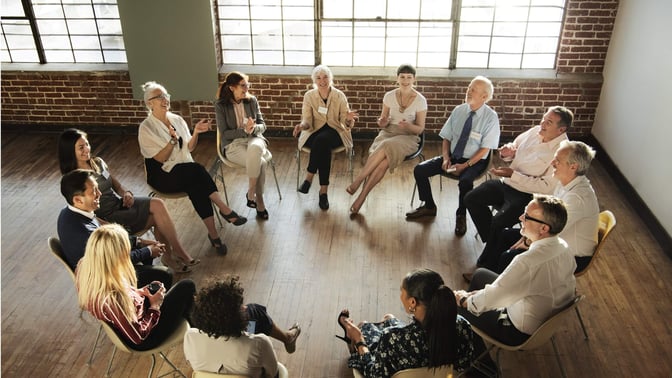Be A Better Ally By Understanding Microaggressions at Work
Posted on May
25,
2021 by Bailey Crumpton. Tagged:
Resources for Candidates,
For Candidates,
Resources for Entrepreneurs,
For Clients,
DEIB
When you read the title of this piece, what was your first reaction? Did you cringe with discomfort or maybe want to smash the patriarchy? Whatever your familiarity with the subject, the word “microaggressions” often gets a bad rap, or is only associated with pc-culture and victimization. Instead, we encourage businesses to work towards understanding microaggressions at work. View this practice as an opportunity to increase inclusivity in the workplace.
A microaggression is defined as a statement, action, or incident regarded as an instance of indirect, subtle, or unintentional discrimination against members of a historically marginalized group. Breaking down what is considered a microaggression can help us treat each other more fairly, and recognize our own subconscious bias. In order to create more equitable workplaces and positive work cultures, we must not dismiss the voices of people facing these issues.
Why Addressing Microaggressions Matters
Have you ever heard the expression “death by a thousand cuts?” The metaphor represents that even if one cut is not fatal, thousands of cuts will eventually lead to something worse. For a lot of people, experiencing microaggressions at work resembles this sensation. Over time, if microaggressions and pointed comments are not confronted, being in that space feels exhausting.
From a recent survey, 68% of Americans say microaggressions are a serious problem in the workplace. That means that over two-thirds of individuals in any given workplace have likely experienced microaggressions. If you feel like your place of work, your school, or anywhere you regularly spend time is hostile, or less validating of your personal experience, it takes a toll. It can leave people feeling isolated, and lowers their confidence and ability to solve problems.
For example, a non-BIPOC individual who says to their Black co-worker that they “don’t see color,” is committing a microaggression. While the intention may be to say “I see you as my equal,” what it actually signals is that they do not value the differences of that person’s lived experience or recognize that part of their identity. This also applies to many other sub-groups as well including women, the LGBTQIA+ community, the AAPI community, and many others. In this way, microaggressions undermine a culture of real inclusion and reinforce dynamics of privilege and power. If you want your employees to reach their maximum potential and engagement levels, addressing toxic aspects of your company’s culture is an imperative first step.
Be Aware, Then Take Action
Even though most microaggressions do not have an overtly racist, sexist, homophobic, etc. intent, they are still hurtful because they are based on assumptions and stereotypes about entire groups of people. Thinking about that one co-worker who is always making jokes with “Asians” or “lesbians” as the punchline? Those jokes at the expenses of others are textbook microaggressions.
Based on the principle that everyone should be able to go to work without having to “let go” of verbal slights and unfair assumptions, the ultimate goal is to create a sense of psychological safety for everyone. CEO of career.place and microaggressions expert Melissa Dobbins suggests that leaders get better at practicing sensitive conversations, and maintain a wide focus. By not singling out a specific demographic or background, you can avoid isolating any group further (creating an us vs them mentality), and indicate that the conversation is meant to be intersectional and inclusive of everyone.
With our home and work lives more blended than ever, there is no better time to confront demeaning interactions. Many people are on board with this kind of learning and growth, so let’s start rebuilding workplaces that hold people accountable in a productive way. Here are three surefire ways for leaders (and really anyone) to practice being more inclusive:
- Lead the Way
- Be open to feedback, and practice listening to understand. When we remove defensiveness from the conversation, we can see each other as people who are worthy of being validated. If leaders are aware of their own bias and actions, and willing to own up when they’ve committed a microaggression, it indicates that workplace is also a safe space to make mistakes and learn. Use your position of leadership and authority to guide your team towards positive change.
- Be open to feedback, and practice listening to understand. When we remove defensiveness from the conversation, we can see each other as people who are worthy of being validated. If leaders are aware of their own bias and actions, and willing to own up when they’ve committed a microaggression, it indicates that workplace is also a safe space to make mistakes and learn. Use your position of leadership and authority to guide your team towards positive change.
- Keep Talking About It
- Don’t give up on having important conversations. The more frequently teams have conversations about identity and inclusion, the higher their comfort level is when addressing more serious issues like interview bias or microaggressions. Try exercises that ask your employees how they have experienced microaggressions, and what can be done moving forward about those dynamics. Revisit topics around workplace inclusion and diversity at least quarterly to measure progress and confront new problems.
- Don’t give up on having important conversations. The more frequently teams have conversations about identity and inclusion, the higher their comfort level is when addressing more serious issues like interview bias or microaggressions. Try exercises that ask your employees how they have experienced microaggressions, and what can be done moving forward about those dynamics. Revisit topics around workplace inclusion and diversity at least quarterly to measure progress and confront new problems.
- Dedicate to the Journey
- When training for a marathon, runners don’t run two measly miles and call it a day. Improving workforce equity is an ongoing, extended approach to training that will take time and commitment. Avoid feeling discouraged when new issues arise. Instead, see them as chances to build on your new workforce equity policies and procedures. Facilitating meaningful change is not a sprint or a competition.

Break It Down or Let It Go? Knowing When To Address Microaggressions
Critics of microaggression theory claim that microaggressions are innocent, or innocuous, and don’t have too much to do with actual racism. You’ve heard it before, the perspective is that those who bring up microaggressions are being overly sensitive, or are somehow using victimhood to get ahead.
On the contrary, a myriad of studies show that microaggressions have a similar, if not more degrading impact than overt incidents of discrimination. Over time, these interactions can make people resentful, low energy, and even leave their job. Since microaggressions are so pervasive, knowing when to address them and when to let it go can be a tough line to draw.
Use the following steps as a template for deciding which course of action is best for you:
Take A Moment. Ask yourself how important the issue and the relationship are to you. If either, or both, are important, avoiding a conversation is not the right approach. You can assert yourself in a way that shows your concern about the issue, while still honoring the relationship you have with that person who has committed a microaggression.
Identify Your Feelings. If you feel anger or aggravation, this is a good sign to take time to find the right words before addressing the situation. If you feel confused, clarifying and asking questions in the moment could resolve the issue, or make someone aware of what they have said or done. Take stock of your emotional bandwidth, and go from there.
Intention vs. Impact. Be prepared for negative feelings or reactions for calling someone out on a microaggression. Learn more about cultivating a call out culture in this post, but know it is common for perpetrators of microaggressions to jump to being defensive. They may say things like, “I’m not racist!” or, “I didn’t mean it like that.” The conversation may be uncomfortable, but so was the microaggression they just expressed towards you. If you are mentally prepared for discussing with someone that impact can be different than intention, you have a higher chance of communicating effectively.
Ask Clarifying Questions. By asking clarifying questions, individuals make space for people to unpack what they have said. Following up an uncomfortable statement with, “what did you mean by that?” gives that person a moment to check themselves, and a chance for you to gauge their intentions. This way, you can refocus the conversation around the impact, and remind that person that you appreciate their willingness to clarify and listen.
Weigh Your Options. However an adverse situation may come about, you have a choice on how you approach handling that situation. If you’re uncomfortable confronting someone on your own, reach out for support by asking a friend or your manager about the best way to address what has happened. For those in historically marginalized groups, it is also up to you how much you allow any given situation to take from you. As BIPOC individuals are already subjected to more bias than other groups, it is also important to protect your time and your joy.

There Is No Inclusion Without Introspection
When it comes to healthy work cultures, understanding microaggressions is a fundamental building block of increasing equity. If you identify as BIPOC, AAPI, or LGBTQ+, you understand more than anyone that the work of allyship is challenging and unending. Allies must be ok with making mistakes, as they are hidden opportunities to grow.
As more organizations are operationalizing diversity, equity, inclusion, and belonging into their cultures, there are important historical factors to consider. BIPOC individuals are used to backlash, criticism, and denial when speaking up, which makes open discussions difficult and fraught with feelings about past experiences. Seeking to understand the experience of your peers is essential to being a successful workplace ally. At base, your colleagues deserve to be believed and listened to.
In conclusion, cultural change takes time and intention. As human beings, we are prone to making mistakes and subconsciously committing microaggressions, whether we intended to or not. The bottom line is that calling out undesirable behavior is not about calling someone a bad person, but rather giving them a chance to be more aware of their biases and the impact that has on others.
Here at BWBacon Group, we know and live what you are experiencing as an employer or job seeker in Denver, Boulder, Dallas, San Francisco, New York City or any of the other cities we work in. We believe great recruiting starts and ends with understanding people.
If you have any questions about living, working or playing any of the areas we serve, please contact us. We are happy to help. Seize the day, every day, that’s what we say!
